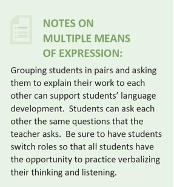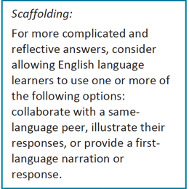Posted in: Aha! Blog > Great Minds Texas | Blog > Implementation Support > Multilingual Learners: Improving Access While Maintaining Rigor
When I was in the classroom, I sometimes struggled to prepare lessons that met the needs of multilingual learners, who, like all students, deserve access to grade-level content. I found myself focusing on either math content or language development separately. But I discovered that when I balanced instruction to attend to both content and language development, my classroom became a place where every student could learn math well. Here are four tips to support multilingual learners with Eureka Math® TEKS.
- Use the suggestions for multilingual learners built into Eureka Math.
In the margin of the Teacher Edition, you’ll find recommendations for instruction that can help you meet the needs of multilingual learners. These may be recommendations about instructional moves, questions to ask, or scaffolds to help students access the content. I found that the advice designed to help multilingual learners helped all my students.
 |
|
- Create effective scaffolds for language development.
Scaffolding instruction allows all students to access grade-level content. I’ve found the following scaffolding strategies helpful:
-
- Use visuals and manipulatives. Visuals and concrete objects help support students as they make sense of new ideas and communicate their thinking to others.
- Use sentence stems. Sentence stems help students express their thinking both verbally and in writing by giving them structure for their ideas. Sentence stems can be general (e.g., I notice ___) or specific (e.g., ___ is greater than ___.).
- Model the use of language by thinking aloud. When you talk through your thought process, you provide a window into the language a mathematical thinker uses in context. This practice is particularly helpful when introducing new terminology.
- Encourage students to show their solutions with more than just words. Drawings such as those created in the Read–Draw–Write process give students opportunities to show their thinking without using words.
- Highlight vocabulary during the lesson and reinforce that vocabulary during the Debrief.
Rather than teaching vocabulary before beginning a lesson, use students’ experiences throughout the lesson to introduce new terminology. Context makes the meaning of words clearer and fosters deep understanding. Call out new vocabulary when it’s used throughout the lesson. When you get to the lesson Debrief, highlight key mathematical vocabulary. This practice is especially beneficial for students who are learning English, but you’ll find that it supports all students as they learn to speak the language of math.
- Take advantage of the language skills that students bring to the classroom.
Multilingual students enter the classroom ready to view the world through their own cultural lens and linguistic background. When students are required to use only English in class, it limits their ability to engage with the content and express their thinking, which creates an equity gap. Instead, ask students to use their linguistic resources in the math classroom. For example, you might ask students to turn and talk with a home language peer, if one is available, or to summarize the learning in their home language. Provide extra response time for multilingual students to gather their thoughts.
The diversity of our classroom communities is what makes them exciting places to collaborate. Use your knowledge of your students and the supports provided in Eureka Math TEKS to engage multilingual students as valuable contributors to classroom learning.
Submit the Form to Print
.png)
Denise Dierolf
Denise Dierolf is a Eureka Math Implementation Leader. She provides professional development and implementation support to schools and districts using Eureka Math across the country. Previously, she taught third grade and served as an instructional coach and assistant principal in Washington, DC.
Topics: Implementation Support



.png?width=111&height=100&name=TEXAS-Phd_LOGO_58C76Y_purple_tpt%20(13).png)

.png?width=73&name=image%20(4).png)


.jpg?width=430&name=PhD%20Science%20(1).jpg)





.jpg?width=430&name=EurekaMath%20(1).jpg)
.jpg?width=430&name=WitWisdom%20(1).jpg)

